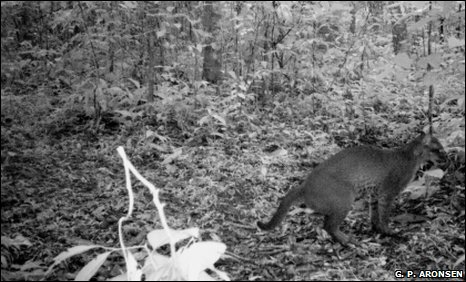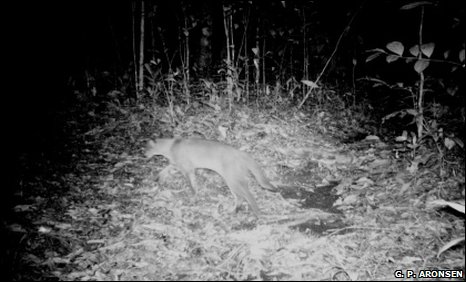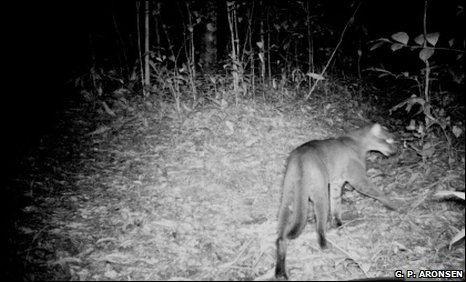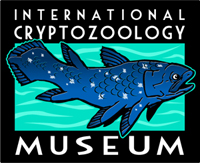Trailcam Captures Melanistic Golden Cat
Posted by: Loren Coleman on September 17th, 2009
Rare and unique photographs of an African golden cat (Profelis aurata) have been taken.

One of the most elusive of all wild cats has been photographed deep in the jungle of Uganda.
Three images of a wild African golden cat were taken by a digital infrared camera trap set up by biologist Dr. Gary Aronsen of Yale University in the US.
To his knowledge, just one other image of a wild African golden cat has ever been published [from the wild, taken in the Democratic Republic of Congo].
Although taken in black and white, the new photos reveal this particular golden cat actually has a dark coat.
The cat is so rare few researchers working in African forests have seen it….
~ Matt Walker of Earth News

Anecdotal evidence suggests that while many villagers and locals may see the cat crossing roads, or maybe raiding domesticates, there are just not that many researcher sightings. We’re usually looking for other things.
There is very little known about this felid, what kind of habitat it prefers.
It is spread across equatorial Africa, but it is cryptic and we presume solitary, making observations few and far between.
The golden cat is melanistic, meaning that its colour varies over its lifetime, and across the continent.
I was disappointed that the cameras could not give me more data on [the cat’s] colour, but the images suggest it is a ‘dark phase’ cat.
For the most part, the cameras capture amazing images of elephants, monkeys, chimpanzees, duiker and buffalo. The cameras also can record movies, so you can see multiple animals in a group, such as chimpanzees.
That meant that the camera was located within the cat’s core area.
Given that three images were captured within an old-growth patch, I’d say that the Kibale golden cats may prefer this habitat. But the range of any cat is large, and so they can go anywhere to hunt.
~ Dr. Gary Aronsen, Yale University
Aronsen’s report and photographs are published in the African Journal of Ecology.

Thanks to the news tip to Cryptomundo from correspondent Mike Olshan.
∆∆∆∆∆∆∆∆∆∆∆∆∆∆∆∆∆∆∆∆∆∆∆

Support the new, public, physical location of the International Cryptozoology Museum in downtown Portland, Maine. Help us achieve the successful future this great adventure promises. No donation is too small. A plaque naming all of the “Museum Heroes,” those who have donated from $1.00 to $1050+, will be placed on the new location’s wall.
Please click on the button below (not the one up top) to take you to PayPal to send in your museum donation.
If you wish to send in your donation via the mails, by way of an international money order or, for the USA, via a check or money order, please use this snail mail address:
Loren Coleman
International Cryptozoology Museum
PO Box 360
Portland, ME 04112
Thank you, and come visit the museum at 661 Congress Street, Portland, Maine 04101, beginning November 1, 2009!! The museum is not a 501(c)3.
About Loren Coleman
Loren Coleman is one of the world’s leading cryptozoologists, some say “the” leading living cryptozoologist. Certainly, he is acknowledged as the current living American researcher and writer who has most popularized cryptozoology in the late 20th and early 21st centuries.
Starting his fieldwork and investigations in 1960, after traveling and trekking extensively in pursuit of cryptozoological mysteries, Coleman began writing to share his experiences in 1969. An honorary member of Ivan T. Sanderson’s Society for the Investigation of the Unexplained in the 1970s, Coleman has been bestowed with similar honorary memberships of the North Idaho College Cryptozoology Club in 1983, and in subsequent years, that of the British Columbia Scientific Cryptozoology Club, CryptoSafari International, and other international organizations. He was also a Life Member and Benefactor of the International Society of Cryptozoology (now-defunct).
Loren Coleman’s daily blog, as a member of the Cryptomundo Team, served as an ongoing avenue of communication for the ever-growing body of cryptozoo news from 2005 through 2013. He returned as an infrequent contributor beginning Halloween week of 2015.
Coleman is the founder in 2003, and current director of the International Cryptozoology Museum in Portland, Maine.










Great photos, beautiful cat.
Awesome cat. It IS a shame not more is known about it. Hopefully one will be captured or at least “studied” in close proximity. Great post and great news, Loren.
Thanks for this, nice photos. It is telling how this US researchers says, “Anecdotal evidence suggests that while many villagers and locals may see the cat crossing roads, or maybe raiding domesticates, there are just not that many researcher sightings. We’re usually looking for other things. …
It is spread across equatorial Africa, but it is cryptic and we presume solitary, making observations few and far between.”
Doesn’t this remind you of another elusive large mammal that has a large distribution and is seen by many local communities, but most scientists and the public believe doesn’t exist, as it would surely have been properly photographed by now?
Miss G-force: Well, I have no idea what animal you could possibly be talking about.
But it just might – like this one – be an animal that many people see. And have many very good reasons for not reporting.
This one?
It’s a cat. Looks like, well, a cat. And a pretty innocuous one at that. Many people see it, and know that all their friends see it, so it’s just not a big deal to them, as it is to the researchers who – they say it themselves – are usually looking for something else. Sightings – as they are with most truly wild animals – are generally brief, and the natives of the areas where it lives probably have very many fleeting glimpses of a wide variety of local animals. This one just doesn’t excite them that much, largely because people from outside don’t come around asking them much about it.
That one? (OK, presuming here, bear with me.)
Looks like an animal of which there are absolutely NONE, got that, NONE in the places where this one lives, so if you see one you are, by definition, crazy and will likely be ostracized by most if not all who know you, including family, and maybe fired from your job. (Good luck getting a recommendation.) Some communities in the southern US, now …but let me let a witness tell you: “There are many sightings in the general area. People in Louisiana don’t like to have conversations about things they don’t understand so not many people talk about their sightings. Maybe they don’t talk much about them because they’re so common.” One researcher, tossing out a number, speculated ten times the number of actual sightings as reports. (He’s a scientist, in a field very relevant to the subject.)
Does that one remind me of this one? Well, for different reasons, maybe.
But, well, yes. 😉
DWA, sorry for the late reply. Clearly, I was being too cryptic. I was referring to the Bigfoot/Almasty, which most be the mostly widely dispersed and largest cryptid around (and has been seen by many people, albeit if only by a very tiny % of the total population).
I agree that ‘fear of ostracization’ is probably the biggest hurdle to cryptozoology. However, I thought it was interesting to see this researcher admit that ‘they are usually looking for other things’ (than a large, widely dispersed and locally known but very elusive mammal). So, I started thinking that could also be a major contributor to the problems faced by cryptozoology. For example, when you see TV programmes about scientific expeditions, they seem to put most of their effort into trying to catch small creatures (fine nets to catch birds and fish etc.) I’m sure it’s much easier to trap lots of small creatures and greatly increase the chances of the researchers discovering a new species, then it is to trap a single very large one.
And the case of this large cat is also a good example of how very, very hard it can be to get even a couple of photos of an already known and large, but elusive, mammal species (another of the hurdles in getting more acceptance of our wild hominid friend).
One thing that this particular cat is not is melanistic. It appears to be a tawny colored, unspotted individual. Melanistic African Golden Cats do occur; according to the IUCN/SSC Cat Specialist Group’s website, about 4% are melanistic. The melanistic cats are solid black & there is no confusing them with either of the other four color phases (tawny reddish or gray, with or without spots).